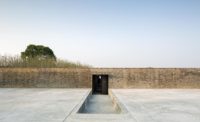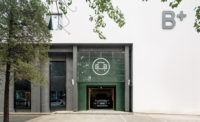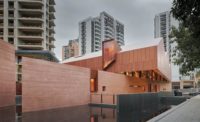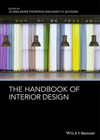Design Vanguard 2009: Neri & Hu Design and Research Office

For their Neri & Hu Collection, the architects have designed products ranging from tea cups and salt-and-pepper shakers to tables and chairs. The objects combine clean modern lines with an easy-going, playful sensibility.
Photo courtesy Neri & Hu

The architects renovated and reskinned a five-story office building on a tree-lined street in the French Concession to create a new headquarters for their architecture firm and their furnishings retail company, Design Republic. They clad the ground floor with wood and inset large windows and glass doors to provide access to a new Design Republic gallery and store. (The original store is on the Bund.) “We approached the store as an extension of the street,” states Neri.
Photo © Derryck Menere

The architects renovated and reskinned a five-story office building on a tree-lined street in the French Concession to create a new headquarters for their architecture firm and their furnishings retail company, Design Republic. They clad the ground floor with wood and inset large windows and glass doors to provide access to a new Design Republic gallery and store. (The original store is on the Bund.) “We approached the store as an extension of the street,” states Neri.
Photo © Derryck Menere

The architects renovated and reskinned a five-story office building on a tree-lined street in the French Concession to create a new headquarters for their architecture firm and their furnishings retail company, Design Republic. They clad the ground floor with wood and inset large windows and glass doors to provide access to a new Design Republic gallery and store. (The original store is on the Bund.) “We approached the store as an extension of the street,” states Neri.
Photo © Derryck Menere

The architects renovated and reskinned a five-story office building on a tree-lined street in the French Concession to create a new headquarters for their architecture firm and their furnishings retail company, Design Republic. They clad the ground floor with wood and inset large windows and glass doors to provide access to a new Design Republic gallery and store. (The original store is on the Bund.) “We approached the store as an extension of the street,” states Neri.
Photo © Derryck Menere

Set in the basement of The Opposite House, a boutique hotel designed by Kengo Kuma, Punk combines heavy materials such as blackened bronze with smoky-glass panels to create an edgy bar targeted at club kids who have grown up and become more affluent. The architects enclosed the bar with a double-layer screen made of perforated bronze plates on the outside and glass and wood on the inside. Colored light between the screen’s two layers and wood shelves and booths add warmth to the otherwise industrial palette of materials.
Photo © Derryck Menere

Set in the basement of The Opposite House, a boutique hotel designed by Kengo Kuma, Punk combines heavy materials such as blackened bronze with smoky-glass panels to create an edgy bar targeted at club kids who have grown up and become more affluent. The architects enclosed the bar with a double-layer screen made of perforated bronze plates on the outside and glass and wood on the inside. Colored light between the screen’s two layers and wood shelves and booths add warmth to the otherwise industrial palette of materials.
Photo © Derryck Menere

Set in the basement of The Opposite House, a boutique hotel designed by Kengo Kuma, Punk combines heavy materials such as blackened bronze with smoky-glass panels to create an edgy bar targeted at club kids who have grown up and become more affluent. The architects enclosed the bar with a double-layer screen made of perforated bronze plates on the outside and glass and wood on the inside. Colored light between the screen’s two layers and wood shelves and booths add warmth to the otherwise industrial palette of materials.
Photo © Derryck Menere

In this entry to a design competition, the architects envisioned the project as a “new landscape” with a series of buildings floating above expansive pools of water that serve as an abstract element separating the new from the old. The billowing facades of the buildings reflect and refract light rippling from the surrounding water. Visitors enter the complex from below ground, one level below the datum of water, then can gather in plazas and ascend grand stairs leading to the buildings. Neri and Hu see the new landscape as comprising the ground, the water, and the clouds.
Rendering courtesy Neri & Hu

In this entry to a design competition, the architects envisioned the project as a “new landscape” with a series of buildings floating above expansive pools of water that serve as an abstract element separating the new from the old. The billowing facades of the buildings reflect and refract light rippling from the surrounding water. Visitors enter the complex from below ground, one level below the datum of water, then can gather in plazas and ascend grand stairs leading to the buildings. Neri and Hu see the new landscape as comprising the ground, the water, and the clouds.
Rendering courtesy Neri & Hu

In this entry to a design competition, the architects envisioned the project as a “new landscape” with a series of buildings floating above expansive pools of water that serve as an abstract element separating the new from the old. The billowing facades of the buildings reflect and refract light rippling from the surrounding water. Visitors enter the complex from below ground, one level below the datum of water, then can gather in plazas and ascend grand stairs leading to the buildings. Neri and Hu see the new landscape as comprising the ground, the water, and the clouds.
Rendering courtesy Neri & Hu

The architects envisioned this restaurant in The Opposite House hotel (on the same level as Punk Bar) as a clearing in the forest and wrapped it with a wooden screen evocative of trees. Inside the main dining room, they kept the ambient light level low and suspended naked bulbs at various heights to create abstract “birds” flying above the tables. A raw bar with a long concrete counter anchors one side of the room and draws attention with a large mirror surrounded by a purple-lit wall. The mirror allows diners at the bar to watch the chefs from in front and behind as they prepare dishes. Beyond the main room, five private dining rooms provide an alternative experience, their walls and floors clad in warm oak. These smaller spaces also offer customers a hint of the city beyond the forest — in the form of glass clerestory panels printed with urban scenes and lit from behind.
Photo © Derryck Menere

The architects envisioned this restaurant in The Opposite House hotel (on the same level as Punk Bar) as a clearing in the forest and wrapped it with a wooden screen evocative of trees. Inside the main dining room, they kept the ambient light level low and suspended naked bulbs at various heights to create abstract “birds” flying above the tables. A raw bar with a long concrete counter anchors one side of the room and draws attention with a large mirror surrounded by a purple-lit wall. The mirror allows diners at the bar to watch the chefs from in front and behind as they prepare dishes. Beyond the main room, five private dining rooms provide an alternative experience, their walls and floors clad in warm oak. These smaller spaces also offer customers a hint of the city beyond the forest — in the form of glass clerestory panels printed with urban scenes and lit from behind.
Photo © Derryck Menere

The architects envisioned this restaurant in The Opposite House hotel (on the same level as Punk Bar) as a clearing in the forest and wrapped it with a wooden screen evocative of trees. Inside the main dining room, they kept the ambient light level low and suspended naked bulbs at various heights to create abstract “birds” flying above the tables. A raw bar with a long concrete counter anchors one side of the room and draws attention with a large mirror surrounded by a purple-lit wall. The mirror allows diners at the bar to watch the chefs from in front and behind as they prepare dishes. Beyond the main room, five private dining rooms provide an alternative experience, their walls and floors clad in warm oak. These smaller spaces also offer customers a hint of the city beyond the forest — in the form of glass clerestory panels printed with urban scenes and lit from behind.
Photo © Derryck Menere

At this flagship store for the Pedder Red shoe brand in Hong Kong’s Central district, Neri and Hu designed a two-story wooden box that provides storage space while also grabbing attention. The architects clad the box with strips of stained-oak arranged in a woven pattern to evoke the stitching found on shoes. Deep niches on the outside of the box are painted red and provide display space for merchandise, while the red continues on the inside where a spiral stair leads to the second level. At most stores the storage area is hidden away, but here it takes center stage. The architects say they wanted to break with retail conventions and make the storage box the heart of the store.
Photo © Derryck Menere

Although a small commission, this memorial site for a family brings together many elements that run through Neri and Hu’s body of work — in particular the use of architecture and design to interpret culture. Here they apply their skill at shaping objects and designing furniture to create markers and pavers set within a bamboo grove at Suzhou Cemetery. Carving out a path in the grove, they establish a simple but elegiac procession leading to an outdoor room where an angled metal wall honors the family’s dead and looks onto a small lawn where people can gather and remember.
Photo © Derryck Menere

Although a small commission, this memorial site for a family brings together many elements that run through Neri and Hu’s body of work — in particular the use of architecture and design to interpret culture. Here they apply their skill at shaping objects and designing furniture to create markers and pavers set within a bamboo grove at Suzhou Cemetery. Carving out a path in the grove, they establish a simple but elegiac procession leading to an outdoor room where an angled metal wall honors the family’s dead and looks onto a small lawn where people can gather and remember.
Photo © Derryck Menere

















Architects & Firms
From teacups and branding to hotels and master planning, Lyndon Neri and Rossana Hu have embraced a broad swath of design work since starting their firm, Neri & Hu Design and Research Office (NHDRO), in Shanghai in 2004. Coming from Michael Graves’s office, both partners saw nothing unusual in moving from one scale to another — designing ceramic salt-and-pepper shakers one moment, then the plan for the mixed-use Legation Quarter in Chengdu the next. “It helps us develop a multifaceted approach,” says Neri. “Today, there’s a lot more crossover between fields. Marcel Wanders goes from products to hotels. Sejima designs furniture. Even Zumthor does a candlestick for Alessi.” Hu adds, “It opens your mind so you don’t get caught up in your own world. Doing just a certain type of architecture—with all the theory and history—can trap you in a box.”
The husband-and-wife team has taken an entrepreneurial approach to their careers, moving beyond design in 2005 to found Design Republic, a retail company that sells furnishings and furniture from local and international companies to China’s emerging middle class. And they helped bring the interiors trade show 100% Design to Shanghai in 2008 and 2009. Recently they completed their own headquarters building at 88 Yuqing Road in Shanghai, which houses a Design Republic store on the ground floor and offices for NHDRO and Design Republic upstairs. Now they have 22 projects on the boards, including a boutique hotel, called The Water House, on the Bund in Shanghai; a Westin hotel and museum in Xian; a seven-story residential complex in Shanghai; and houses in Shanghai, Mexico, Singapore, and the United States. NHDRO’s 70-person staff hails from roughly 20 different countries, which is helping the firm tackle more international commissions. “Working globally has created a different dynamic in the office and forced us to rethink how we do things,” states Neri. In response to the expanding scale and scope of their work, Neri and Hu have hired an old friend from the U.S. who has experience working on and managing large architecture projects.
“One recurring theme in our work is exploring cultural identity,” states Hu, who was born in Taiwan and moved to the United States at age 12. (Neri was born in the Philippines and moved to the U.S. when he was 15.) Since both of the partners are members of the Chinese diaspora and studied and worked in the U.S. for many years, they bring a different perspective on what it means to be Chinese or Asian. “We interpret culture through architecture,” she explains. “I think we’re becoming more abstract — using signs and symbols and materials to express identity. And we’re exploring certain nonvisual vehicles — such as poetry, literature, and storytelling — to do this.” Neri and Hu’s path from Michael Graves and Postmodernism to a growing abstraction contrasts with that of architects like Yung Ho Chang, who returned to China in 1993 after studying in the U.S. and took a more Modernist stance until recent years, when he began to incorporate elements taken from China’s vernacular and craft traditions. Ironically, both NHDRO and Chang may end up in the same place after coming from different aesthetic directions.
“It’s all about the appropriateness of a particular approach to a specific project and place,” says Neri. “Sometimes we end up contradicting ourselves, because we’re still experimenting. It’s both exciting and frustrating.” The firm is working on a 35-story tower in Hunan, for example, and wrestling with a new scale and new ideas. “It’s a design breakthrough for us, but it’s borderline ugly,” Neri laughs. “Our only fear is that we’ll just become commercial” like so many other Chinese firms.
























